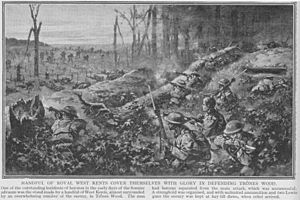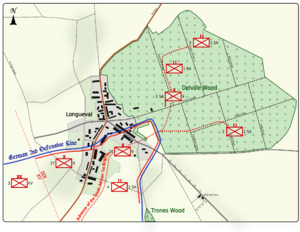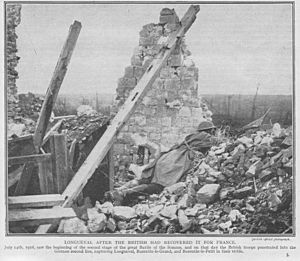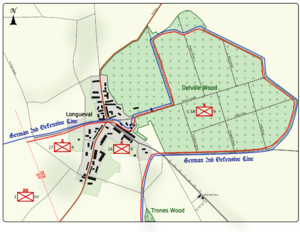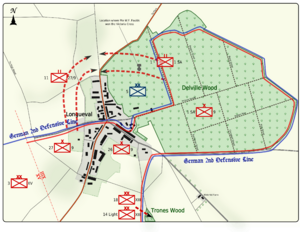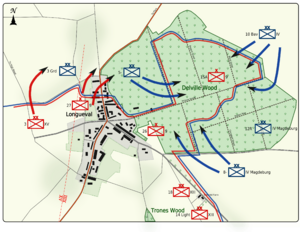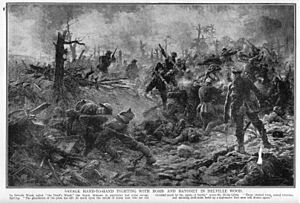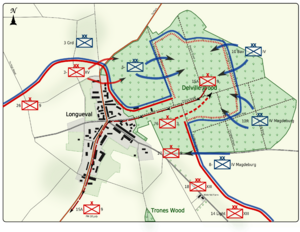Battle of Delville Wood facts for kids
Quick facts for kids Battle of Delville Wood |
|||||||
|---|---|---|---|---|---|---|---|
| Part of The Battle of the Somme of the First World War | |||||||
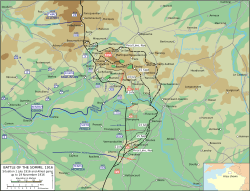 |
|||||||
|
|||||||
| Belligerents | |||||||
| Commanders and leaders | |||||||
| Douglas Haig Henry Rawlinson |
Fritz von Below Max von Gallwitz |
||||||
| Strength | |||||||
| 8 divisions, 1 brigade | |||||||
The Battle of Delville Wood (15 July – 3 September 1916) was a long and fierce fight during the Battle of the Somme in World War I. It took place between the armies of the German Empire and the British Empire. Delville Wood, also known as Bois d'Elville, was a dense forest with many trees and thick bushes. It was located east of a village called Longueval in France.
The battle was part of a larger attack by the British starting on 14 July. This attack aimed to capture German positions between Delville Wood and another area called Bazentin le Petit. The British succeeded in their first goal, but it came at a high cost. Fighting for the wood continued for seven weeks. The 1st South African Infantry Brigade fought for the first time on the Western Front as part of the 9th (Scottish) Division. They captured Delville Wood on 15 July. The South Africans held the wood until 19 July, suffering many casualties.
The village and the wood formed a "salient," which means they stuck out into enemy lines. This made them easy targets for German artillery from three sides. The British tried to advance on both sides of the wood to make their lines straighter. The Germans wanted to get rid of this salient and keep the high ground, which gave them a good view of British positions. For July and August, both sides fought hard for control of the wood and village.
Bad weather made it hard to move troops and supplies. Shortages of ammunition and many wounded soldiers meant that attacks were often small. Most attacks failed because of strong enemy fire and the terrible muddy conditions. Today, Delville Wood is a preserved site with old trenches, a museum, and a monument to the South African Brigade.
Background to the Battle
War Strategy in 1916
In 1916, the British and French armies learned from past mistakes. They realized that a quick breakthrough against German defenses was impossible. Instead, they planned smaller attacks over a wide area. These attacks would start after heavy artillery shelling. The goal was to slowly "nibble away" at German defenses.
The main attack was split between British forces in the north and French forces in the south. After two weeks, the Germans were still holding strong in the northern and central British areas. However, the British and French had made good progress south of the Albert–Bapaume road.
German commanders were ordered to hold every inch of ground. They were told to counter-attack immediately if any ground was lost. General Fritz von Below even said, "The outcome of the war depends on the Second Army being victorious on the Somme." This showed how important the Somme front was to Germany.
German Army Changes
On 19 July, the German 2nd Army was split into two. A new 1st Army was created to control German troops north of the Somme River. General Max von Gallwitz took charge of the 2nd Army and also oversaw the 1st Army. This change aimed to improve how the German forces were managed.
The Germans faced many challenges. Moving troops and supplies was very dangerous due to constant shelling. German units often had very few soldiers left after fighting. Many German commanders suggested changing their defense plans. They tried to hold the front line lightly, with more reserves further back. But this did not stop the heavy losses from British and French artillery.
Work on new defense lines was constant, but materials were scarce. Supply trains were delayed, and stations near the front were bombed. German artillery also suffered heavy losses. Many guns were damaged, and some ammunition exploded too early. The British and French also had better air control. Despite these problems, German air support began to improve by mid-July.
Preparing for Battle
British Plans and Attacks
British attacks south of the Albert and Bapaume road began on 2 July. Supply routes were very busy. Key areas like La Boisselle, Bernafay Wood, and Caterpillar Wood were captured. Fierce fighting continued for Trônes Wood, Mametz Wood, and Contalmaison until 14 July.
As German reinforcements arrived, they were sent into battle quickly. This led to many casualties on both sides. Operations became improvised, meaning they were not well-planned. Troops often did not know the area, and artillery support was poor. Sometimes, friendly troops were even shelled by mistake.
The Battle of Bazentin Ridge (14–17 July) was a joint attack. British troops moved into no man's land in the dark. At dawn, a quick, intense artillery bombardment began. The British then ran forward. On the right, the 18th (Eastern) Division captured Trônes Wood. The 9th (Scottish) Division got into Delville Wood. By mid-morning, a large part of the German second position was captured. This caused chaos among the German defenders.
Longueval and Delville Wood Layout
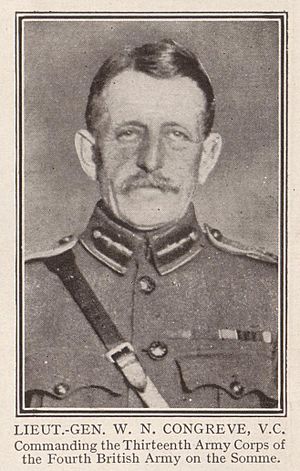
The village of Longueval had important crossroads. These roads led to other key locations like Montauban, Bazentin, Flers, and Ginchy. South African forces used English names for places in Longueval and Delville Wood, which were easier to understand.
Delville Wood was next to the east side of Longueval. It was a large area, about half a square mile. The wood had several paths or "rides" running through it, like Prince's Street, Buchanan Street, and King Street. These paths were important for moving troops and fighting.
General Sir Henry Rawlinson, who commanded the British Fourth Army, ordered his troops to capture Longueval. This advance could not begin until Trônes Wood was taken, as it overlooked the approach. Capturing Longueval also meant taking Delville Wood. If the wood was not captured, German artillery could easily see into the village. It would also give German infantry a perfect place to launch attacks on Longueval.
The 9th (Scottish) Division was chosen to attack Longueval. The 26th Brigade would lead the attack. Once Longueval was secure, the 27th Brigade would then move through to take Delville Wood. The 1st South African Brigade was kept in reserve.
German Defenses
German defensive plans in 1916 focused on holding ground firmly and launching quick counter-attacks. By early 1916, their defenses were very strong. They had wide barbed wire obstacles, sometimes 30 yards wide. Their front line had three trenches, with deep dugouts for soldiers.
An intermediate line of strongpoints was built about 1,000 yards behind the front line. This second line was far enough back to be out of range of Allied field artillery. This meant attackers would have to stop and move their guns forward before attacking this line.
Longueval village was heavily fortified with trenches, tunnels, and concrete bunkers. It also had two field guns. The wood itself was on a slight ridge. German commanders suspected a British attack would come on 13 or 14 July.
The Battle for Delville Wood
French Army Actions
On 14 July, the French Sixth Army was pushed back from Biaches, south of the Somme. They quickly retook the area. On 20 July, French troops attacked Barleux. They took the German front trench but were stopped by heavy machine-gun fire. They were pushed back with many casualties.
On the north side of the Somme, the French Sixth Army slowly advanced. They aimed to capture the German second position from Cléry to Maurepas. On 20 July, French divisions attacked. Some units advanced well, taking key areas. Others were stopped by machine-gun fire.
South African Brigade's Fight (14–20 July)
The British attack on 14 July began just before dawn. Infantry moved forward across no man's land and attacked after a short, intense bombardment. The attack on Longueval was initially successful. British troops reached the village square, fighting house-to-house. However, German reinforcements arrived, and heavy fire from Delville Wood stopped the British advance.
The 27th Brigade, meant for Delville Wood, was used to help in Longueval. At 1:00 p.m., the 1st South African Brigade was ordered to take the wood "at all costs." The attack was delayed until 5:00 a.m. on 15 July. Brigadier-General Henry Lukin ordered his troops to advance even if Longueval was not fully captured.
The South African attack on 15 July met little resistance at first. By 7:00 a.m., they had captured the southern part of the wood. They then tried to secure the northern edge. The South African Brigade began to dig in around the wood. However, digging proper trenches was hard due to roots and tree trunks. They could only make shallow scrapes before German counter-attacks began.
German counter-attacks came from the south-east and north-east. These attacks were pushed back, but the South Africans suffered losses. German forces gathered to the north of the wood. South African commanders were told to keep digging, as heavy shelling was expected. German shelling increased in intensity, and a counter-attack began at midnight. German troops managed to get close but were stopped by artillery and machine-gun fire.
On 16 July, the South Africans tried to capture the north-west part of the wood. But their numbers were too low, and the attack failed. The 27th Brigade was also pinned down in Longueval. The situation became desperate.
On the evening of 16 July, the South Africans pulled back to prepare for a bombardment. On 17 July, they attacked again but failed. Survivors were driven back to their original positions. German shelling increased. During the night, the German 3rd Guards Division attacked. They drove the South Africans back from their front trenches, causing many casualties.
The Germans saw the South Africans forming up and fired an intense bombardment. Every part of the wood was hit. German troops attacked from the north-west corner of the wood. By 2:00 p.m., the South African position was desperate. German attacks came from all sides.
On 18 July, the South Africans received support from the 76th Brigade. They attacked into the wood to link up with the South Africans. A German bombardment became very intense at sunrise. About 400 shells per minute fell into Longueval and the wood. Heavy rain also turned the shell-craters into mud.
At 3:15 p.m., German infantry attacked from the east, north, and north-east. They were cut down by small-arms fire. The main German attack came from the north and north-east. Elements of nine battalions attacked with 6,000 men. Hand-to-hand fighting happened all over the wood. The South Africans were split into small groups.
A German officer described Delville Wood as "a shattered wasteland of shattered trees, charred and burning stumps, craters thick with mud and blood, and corpses, corpses everywhere." By 19 July, the South African survivors were being shelled and sniped at close range.
On the morning of 19 July, German troops attacked the 3rd South African Battalion from behind. They captured many soldiers. The South Africans were short of water, had no food, and could not evacuate their wounded. Many isolated groups surrendered when they ran out of ammunition.
On 20 July, the 76th Brigade tried again to relieve the 1st South African Brigade. By 1:00 p.m., the South African commander reported his men were exhausted. Troops from the Suffolk Regiment and the Royal Berkshires broke through to join the last South African troops. The remaining South Africans marched out of the wood, led by their commander. A piper played them out. The survivors withdrew to a place called Happy Valley.
Continued Fighting (21 July – 3 September)
| Date | Rain mm |
°F | |
|---|---|---|---|
| 1 July | 0.0 | 75°–54° | haze |
| 2 July | 0.0 | 75°–54° | fine |
| 3 July | 2.0 | 68°–55° | fine |
| 4 July | 17.0 | 70°–55° | rain |
| 5 July | 0.0 | 72–52° | dull |
| 6 July | 2.0 | 70°–54° | rain |
| 7 July | 13.0 | 70°–59° | rain |
| 8 July | 8.0 | 73°–52° | rain |
| 9 July | 0.0 | 70°–53° | dull |
| 10 July | 0.0 | 82°–48° | dull |
| 11 July | 0.0 | 68°–52° | dull |
| 12 July | 0.1 | 68°–? | dull |
| 13 July | 0.1 | 70°–54° | dull |
| 14 July | 0.0 | 70°–? | dull |
| 15 July | 0.0 | 72°–47° | fine |
| 16 July | 4.0 | 73°–55° | dull |
| 17 July | 0.0 | 70°–59° | mist |
| 18 July | 0.0 | 72°–52° | dull |
| 19 July | 0.0 | 70°–50° | dull |
| 20 July | 0.0 | 75°–52° | fine |
| 21 July | 0.0 | 72°–52° | fine |
| 22 July | 0.1 | 77°–55° | dull |
| 23 July | 0.0 | 68°–54° | dull |
| 24 July | 0.0 | 70°–55° | dull hot |
| 25 July | 0.0 | 66°–50° | dull |
| 26 July | 0.0 | 66°–50° | dull |
| 27 July | 8.0 | 81°–61° | haze |
| 28 July | 0.0 | 77°–59° | dull hot |
| 29 July | 0.0 | 81°–57° | dull |
| 30 July | 0.0 | 82°–57° | fine |
| 31 July | 0.0 | 82°–59° | hot |
British forces continued to attack Delville Wood and Longueval. On 22 July, a bombardment began. The 3rd Division attacked the wood and the north end of Longueval. The attack covered a good distance but was forced back by German machine-guns.
On 27 July, every British gun in range fired on the wood and village. Patrols found "a horrible scene of chaos and destruction." When the bombardment began, about sixty German soldiers surrendered. British infantry advanced into a mess of shell-craters and shattered trees. They reached a trench full of dead and wounded German soldiers.
German artillery continued to fire heavily, causing many casualties. A German counter-attack pushed the British line back. Fighting continued with units being relieved and new attacks launched. The weather often made conditions worse, turning the battlefield into a muddy swamp.
| Date | Rain mm |
°F | |
|---|---|---|---|
| 1 | 0.0 | 82°–59° | hot |
| 2 | 0.0 | 88°–57° | hot |
| 3 | 0.0 | 84°–57° | hot |
| 4 | 0.0 | 79°–52° | — |
| 5 | 0.0 | 68°–48° | fine |
| 6 | 0.0 | 75°–52° | — |
| 7 | 0.0 | 73°–50° | — |
| 8 | 0.0 | 77°–52° | — |
| 9 | 0.0 | 84°–54° | — |
| 10 | 4.0 | 70°–55° | dull |
| 11 | 0.0 | 77°–59° | rain |
| 12 | 1.0 | 82°–63° | — |
| 13 | 0.0 | 81°–59° | wind |
| 14 | 2.0 | 77°–59° | rain |
| 15 | 0.0 | 75°–55° | rain |
| 16 | 2.0 | 75°–55° | — |
| 17 | 4.0 | 72°–54° | rain |
| 18 | 1.0 | 70°–55° | dull |
| 19 | 2.0 | 70°–50° | dull |
| 20 | 0.0 | 72°–54° | dull |
| 21 | 0.0 | 72°–48° | — |
| 22 | 0.0 | 72°–52° | — |
| 23 | 0.0 | 72°–54° | — |
| 24 | 0.0 | 78°–55° | — |
| 25 | 8.0 | 81°–61° | dull |
| 26 | 7.0 | 75°–59° | — |
| 27 | 4.0 | 73°–59° | — |
| 28 | 0.1 | 73°–59° | rain |
| 29 | ? | 82°–59° | rain |
| 30 | 8.0 | 63°–48° | mud |
| 31 | 0.0 | 70°–52° | fine |
| 1 | 0.0 | 72°–52° | — |
| 2 | 0.0 | 75°–52° | wind |
| 3 | 4 | 72°–50° | — |
| 4 | 25 | 66°–52° | rain |
| 5 | 0.0 | 63°–54° | dull |
| 6 | 0.0 | 70°–52° | dull |
On 4 August, a British attack was stopped by German artillery and machine-gun fire. On 7 August, another attack was launched, but the British were stopped while still inside the wood. German defenses seemed much stronger.
On 18 August, British troops attacked again. They advanced behind a creeping artillery barrage. The right side of the attack reached its goal with few losses. But the left side was hit hard by artillery and machine-gun fire. Hand-to-hand fighting occurred.
On 21 August, another British attack on the wood caused nearly 200 casualties. On 24 August, a combined attack with the French aimed to fully capture Delville Wood. British aircraft helped by reporting troop positions. Over 200 prisoners and more than twelve machine-guns were captured.
On 27 August, the last German hold in Delville Wood was removed. A German counter-attack was expected. On 31 August, a very intense German bombardment began. The German attack started at 1:00 p.m. and was pushed back. More German attacks followed, pushing the British back into the wood.
On 1 September, British troops attacked again but made little progress. The fighting continued fiercely. On 3 September, the 7th Division was set to attack Ginchy. A preliminary attack was made to clear the way. The fighting in Delville Wood was some of the most intense of the Somme.
Air Support During the Battle
Aircraft played an important role in the battle. On 14–15 July, 9 Squadron aircraft watched the battle. They directed artillery fire, took photos, and reported infantry positions. British aircraft also used new "Buckingham" tracer ammunition to attack German targets on the ground.
During attacks on 24 August, 3 Squadron aircraft brought back detailed information. They saw British troops lighting red flares to show their positions. This helped the artillery adjust its fire. The aircrews reported back quickly, helping commanders understand the battle.
German Counter-Attacks
German units were sometimes surprised by British attacks. The British managed to break through at some points. German commanders ordered troops to hold their positions and counter-attack. Many German divisions were sent to the Somme front.
On 15 July, German battalions attacked Delville Wood from different directions. But they were stopped by heavy British fire. Further attempts to retake the wood on 16 July also failed with many losses.
On 18 July, the German 8th Division planned to recapture Delville Wood. A huge bombardment turned the wood into an "inferno." German troops attacked in waves from the north-east and north. These attacks were not well-coordinated. Hand-to-hand fighting broke out.
By 20 July, some German regiments were reduced to very few men. They were relieved by other units. The German defense of the Somme was reorganized in July. German troops faced constant British artillery fire. Many German soldiers were taken prisoner.
On 30 July, British shelling caused many casualties. German units were exhausted and needed reinforcements. On 4 August, a British attack began as German units were being relieved. The British artillery kept up a steady bombardment.
On 18 August, German troops were surprised by an attack. Their trenches were almost destroyed by British artillery. German counter-attacks were launched, but they also suffered heavy losses. On 27 August, the last German position in Delville Wood was lost.
A large German counter-attack was planned for 31 August. It involved specialist assault units with flame-throwers. The attack began after a bombardment, but it had little effect on British defenses. The attacks from the east and north faced strong resistance. Many German flame-throwers became unusable in the mud. The German attacks failed to retake the wood.
Aftermath of the Battle
Soldier Losses
The Battle of Delville Wood was very costly for both sides. By the end of July, German losses on the Somme front were around 160,000 men. The British and French had over 200,000 casualties.
The 9th (Scottish) Division had 7,517 casualties from 1 to 20 July. The 1st (South African) Infantry Brigade lost 2,536 men during this period. Other British divisions also suffered thousands of casualties. For example, the 3rd Division had 6,102 casualties from 11 to 27 July.
German losses were also very high. Some German divisions lost around 5,000 men in Delville Wood. One German regiment, which was at full strength on 13 July, had only 260 men left by 20 July. Many German units were in a "pitiable state" after the fighting.
Later Events
The Battle of Flers–Courcelette (15–22 September) was the next major British attack. It continued the advance from Delville Wood and Longueval. This battle was famous for the first use of tanks. The British captured several villages.
The Allies held Delville Wood until 24 March 1918. At that time, German troops broke through, and British forces had to retreat. On 29 August 1918, the 38th (Welsh) Division attacked to retake Delville Wood and Longueval from the south. They faced little resistance and quickly reached their goals. The war ended three months later.
Heroes of Delville Wood
Several soldiers were awarded the Victoria Cross for their bravery during the Battle of Delville Wood:
- Private William Frederick Faulds on 18 July: 1st Battalion, 1st South African Brigade.
- Corporal Joseph John Davies on 20 July: 10th Battalion Royal Welsh Fusiliers.
- Private Albert Hill on 20 July: 10th Battalion Royal Welsh Fusiliers.
- Major William la Touche (Billy) Congreve on 20 July: Brigade Major 76th Brigade.
- Sergeant Albert Gill on 27 July: 1st Battalion King's Royal Rifle Corps.
Images for kids


